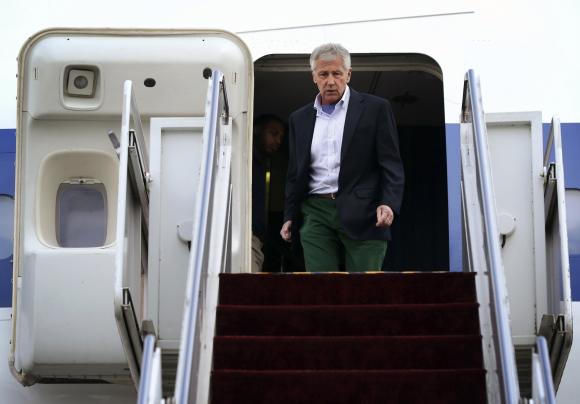(Reuters) – U.S. Defense Secretary Chuck Hagel visited China’s sole aircraft carrier on Monday in an unprecedented opening by normally secretive Beijing to a potent symbol of its military buildup.

A U.S. official said the visit to the carrier the Liaoning, at a port in the northern city of Qingdao, lasted about two hours. No other details were immediately available.
The official believed Hagel was the first official visitor from outside China to be allowed on board the Liaoning, although that could not be immediately confirmed.
China’s Defence Ministry confirmed the visit would happen but did not provide details.
Chinese security experts said Beijing could be trying to quell U.S. criticism that it was not transparent about its military modernization.
Hagel’s carrier visit, at the start of his three-day trip to China, was quietly approved by Beijing at Washington’s request, the U.S. official said, speaking on condition of anonymity.
The 60,000-tonne Liaoning, a Soviet-era vessel bought from Ukraine in 1998 and re-fitted in a Chinese shipyard, is seen as a symbol of China’s growing naval power and ambition for greater global influence.
The carrier has yet to become fully operational, however, and military experts say it could be decades before China catches up to the far superior and larger U.S. carriers – if ever.
Hagel arrived in Qingdao after a trip to Japan.
Reporters travelling with Hagel did not accompany him on the vessel, in what is a rare visit to a sensitive Chinese military site.
It’s a sign of openness, of sincerity, that China has nothing to hide and wants to improve military relations with the United States, said Ni Lexiong, a naval expert at the Shanghai University of Political Science and Law.
It will also be a good opportunity for the Americans to see the difference between the Liaoning and their aircraft carriers, Ni said, referring to the technological gulf between the two countries.
CHINA GETS REGULAR ACCESS
Chinese military brass are no strangers to U.S. warships, including aircraft carriers.
Officers from the People’s Liberation Army are routinely flown to U.S. aircraft carriers en route to occasional port stops in Hong Kong, according to U.S. military officials.
Their U.S. counterparts provide tours of the ship and flight deck during operations – efforts U.S. diplomats say are geared to nudging China towards greater transparency about its capabilities.
Ian Storey, a Singapore-based regional security expert, said earlier that Hagel’s visit would be long on symbolism but short on actual operational capabilities.
By showing him a vessel that was built in Ukraine in the 1980s and remains only a training platform that is still not fully operational, the Chinese will be keeping him away from their more sensitive capabilities, such as their missile programs or submarine fleets, said Storey, of Singapore’s Institute of South East Asian Studies.
China is building submarines, surface ships and anti-ship ballistic missiles, and has tested emerging technology aimed at destroying missiles in mid-air.
The carrier visit came a day after Hagel said he would use his first trip to China as defense secretary to press Beijing to use its great power wisely and respect its neighbors, who have been put on edge by the country’s growing assertiveness in Asia’s disputed waters.
China claims 90 percent of the 3.5 million sq km (1.35 million sq mile) South China Sea, which is believed to be rich in oil and gas. The Philippines, Vietnam, Malaysia, Brunei and Taiwan all claim parts of those waters.
China has a separate dispute with Japan in the East China Sea over uninhabited islets that are administered by Japan. China’s decision in November to declare an air defence identification zone in the area that includes those islands sparked protests from the United States, Japan and South Korea.
China’s official Xinhua news agency, in a commentary released as Hagel arrived, said Hagel had to show he was sincere about improving ties and the United States had to assure its China friend of its intentions.
As the world’s second- and first-largest economies, China and America have a shared interest in a stable environment to facilitate economic prosperity. Neither of them, nor the global economy, can afford confrontation or conflict, Xinhua said.
RISKS OF A MISHAP
Hagel, in his talks in Japan over the weekend and last week at a gathering of Southeast Asian defense chiefs in Hawaii, had sought to reassure allies of the U.S. security commitment to the region and has promised frank discussions in China.
China, in turn, has repeatedly urged the United States not to take sides in any of its disputes in the region, and has watched warily as Washington moves to strengthen its military alliances, especially with Tokyo and Manila, as part of its strategic pivot toward Asia.
Both sides are aware of the potential for military clashes, and the need to increase understanding and manage and reduce the risks, so this visit is a positive sign, said Zhu Feng, director of the International Security Programme at Peking University.
The risks of a mishap were highlighted in December when the American guided missile cruiser USS Cowpens had to take evasive action in the South China Sea to avoid hitting a Chinese warship operating in support of the Liaoning.
The Chinese carrier is the first step in what state media and some military experts believe will be China’s deployment of several locally built carriers by 2020.
While President Xi Jinping recently urged China’s military leadership to work faster to get the carrier combat-ready, some Chinese analysts and parts of the state media appear keen to dampen expectations about the Liaoning, which went on its first training mission into the South China Sea late last year.
The Liaoning would serve as a training platform rather than a fighting weapon, some Chinese experts have said.
Considerable doubt also remains over when it will be fully operational. Earlier estimates of two or three years had grown rubbery, with some hints internally that it could stretch to a decade, some experts say.
(Additional reporting by Ben Blanchard in Beijing and Greg Torode in Hong Kong; Editing by Dean Yates and Robert Birsel)





